microsoft MB-500 Exam Questions
Questions for the MB-500 were updated on : Nov 01 ,2025
Page 1 out of 10. Viewing questions 1-15 out of 142
Question 1 Topic 1, Case Study 1Case Study Question View Case
HOTSPOT
You need to create the new table for the vendor exclusion list.
What should you do? To answer, select the appropriate options in the answer area.
NOTE: Each correct selection is worth one point.
Hot Area:
Answer:

Explanation:
Scenario: You must develop a new solution to maintain a Vendor exclusion list for each customer and item combination. The
solution must meet the following requirements:
Isolate all new vendor exclusion codes as a new assembly by creating a table named VendExclusions.
Create an index for the table named PrimaryIdx that uses the following fields: CustAccount, ItemId, VendAccount.
Ensure that users can open the Vendor Exclusion list report from the customer master form. The list must display the
customer account, Item ID, and Vendor account fields.
Maintain referential integrity with other tables.
Box 1: a table extension for Vendors and relation for the Vendor exclusions
Box 2: RelationShip Type Reference: https://docs.microsoft.com/en-us/dynamics365/fin-ops-core/dev-itpro/data-
entities/develop-composite-data-entities
Question 2 Topic 1, Case Study 1Case Study Question View Case
You need to apply a form pattern to the Vendor exclusion list.
Which pattern should you use?
- A. Workspace
- B. Simple List
- C. List Page
- D. List View
Answer:
C
Explanation:
A list page presents a set of data on a user interface that is optimized so that you can browse records, find the right record,
and then take an action upon that record. The list page lets the user search, filter, and sort the data. FactBoxes on the right
side of the grid show related data for the active record. Actions that are relevant to the record are located on the ActionPane
at the top of the page.
Scenario: You must develop a new solution to maintain a Vendor exclusion list for each customer and item combination. The
solution must meet the following requirements:
Isolate all new vendor exclusion codes as a new assembly by creating a table named VendExclusions.
Create an index for the table named PrimaryIdx that uses the following fields: CustAccount, ItemId, VendAccount.
Ensure that users can open the Vendor Exclusion list report from the customer master form. The list must display the
customer account, Item ID, and Vendor account fields.
Reference: https://docs.microsoft.com/en-us/dynamics365/fin-ops-core/dev-itpro/user-interface/list-page-form-pattern
Question 3 Topic 1, Case Study 1Case Study Question View Case
You need to meet the requirements for the purchase order creation form.
What are two possible ways to achieve this goal? Each correct answer presents a complete solution.
NOTE: each correct selection is worth one point.
- A. Create a class and add a form data source event handler method to the class.
- B. In Application Explorer, create a table extension and implement validation.
- C. In Application Explorer, create a form extension and implement validation.
- D. Implement Chain of Command (CoC) and method wrapping by creating a form extension class.
Answer:
C D
Explanation:
Scenario:
Users must be presented with a warning message before a direct delivery purchase order is created for a vendor in
exclusion list.
You must implement validation to check whether a proposed direct delivery purchase order vendor is on the exclusion list for
the customer and product combination.
Question 4 Topic 1, Case Study 1Case Study Question View Case
DRAG DROP
You need to develop, test, and deploy the Vendor Exclusion list solution.
What should you create? To answer, drag the appropriate objects to the correct actions. Each element may be used once,
more than once, or not at all. You may need to drag the split bar between panes or scroll to view content.
NOTE: Each correct selection is worth one point.
Select and Place:
Answer:
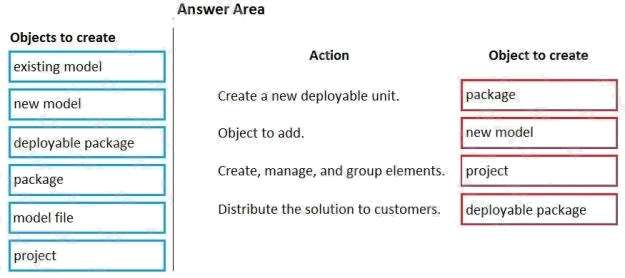
Explanation:
Box 1: package
An AOT package is a deployment and compilation unit of one or more models that can be applied to an environment. It
includes model metadata, binaries, reports and other associated resources. One or more AOT packages can be packaged
into a deployable package, which is the vehicle used for deployment of code (and customizations) on demo, sandbox, and
production environments.
Box 2: New model
Model - You configure your model to refer to two other models. This enables your model to reference metadata and code
elements that are in other packages.
Box 3: project
Project - You create a project and then associate your project to your new model. You add elements to your project, which
are also added to your model. Specifically, you add an extended data type (EDT). You also add a table that you populate
with fields and a method. Box 4: deployable package
Reference: https://docs.microsoft.com/en-us/dynamics365/fin-ops-core/dev-itpro/dev-tools/create-data-model-elements
Plan Architecture and Solution Design
Question 5 Topic 2, Case Study 2Case Study Question View Case
You need to configure filtering for the Vendor Past Due Invoices form.
Which two filtering types can you use? Each correct answer presents a complete solution.
NOTE: Each correct selection is worth one point.
- A. QuickFilter
- B. Advanced Filter
- C. Grid Column Filtering
- D. Filter pane
Answer:
A C
Explanation:
A: QuickFilter: A framework-provided filtering mechanism that can appear above any list or grid, and that provides fast
single-column filtering.
C: Grid column filtering: The user can define filter conditions and perform single-column sorting by using a drop dialog that is
opened from the grid column header.
Scenario: You must create a batch job that runs on the last day of each month to update the current unpaid invoices with
changes in the minimum invoice amount. The job must meet the following requirements:
Allow users to specify vendors to include in the job.
Accept the following parameters: Vendor, DueDate.
Be callable by an Action menu item.
Use SysOperation Framework for all batch jobs.
Reference: https://docs.microsoft.com/en-us/dynamics365/fin-ops-core/dev-itpro/user-interface/filtering
Question 6 Topic 2, Case Study 2Case Study Question View Case
You need to configure models for the project.
What are two possible ways to achieve the goal? Each correct answer presents a complete solution.
NOTE: Each correct selection is worth one point.
- A. Create a new model that extends the existing FinanceExt model.
- B. Overlay the existing FinanceExt model and populate the solution definition.
- C. Extend the existing FinanceExt model and populate the project model definition.
- D. Modify the DefaultModelForNewProject setting in the DefaultConfig.xml file and name the model FinanceExt.
Answer:
B C
Explanation:
All new and extended objects must be located in an existing model named FinanceExt. The creation of new models is not
permitted.
Question 7 Topic 3, Case Study 3Case Study Question View Case
HOTSPOT
You need to implement the integration for the Vendor Exclusion List form.
What should you do? To answer, select the appropriate options in the answer area.
NOTE: Each correct selection is worth one point.
Hot Area:
Answer:

Explanation:
Box 1: Table extension
Isolate all new vendor exclusion codes as a new assembly by creating a table named VendExclusions. Implement the Excel
integration for the Vendor Exclusion List form.
The table extension object allows you to add additional fields or to change some properties on a table provided by the
Dynamics 365 Business Central service. In this way, you can add data to the same table and treat it as a single table.
Box 2: Unique key
Create an index for the table named PrimaryIdx that uses the following fields: CustAccount, ItemId, VendAccount.
Box 3: Build and synchronize the database.
A project property lets you specify that the synchronize operation for the database should be performed every time that you
build the project. This can be useful when youre making changes to the table structure for an application. Each time that you
build, you will know that the database is synchronized with the tables as they are defined in the project.
Reference: https://docs.microsoft.com/en-us/dynamics365/business-central/dev-itpro/developer/devenv-table-ext-object
https://docs.microsoft.com/en-us/dynamics365/fin-ops-core/dev-itpro/dev-tools/build-operations#synchronizing-the-database-
at-each-build
Question 8 Topic 3, Case Study 3Case Study Question View Case
HOTSPOT
The system includes the following code: (Line numbers are included for reference only.)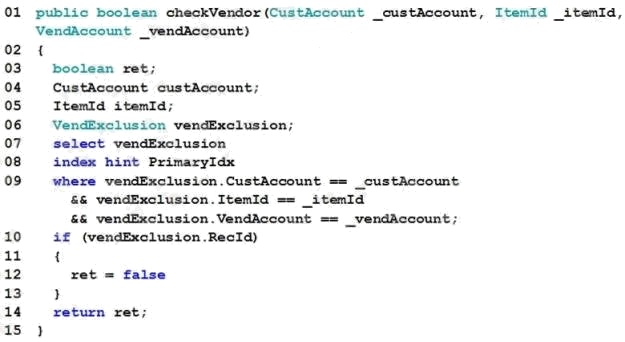
You need to apply changes to address User2s issues.
For each of the following statements, select Yes if the statement is true. Otherwise, select No.
NOTE: Each correct selection is worth one point.
Hot Area: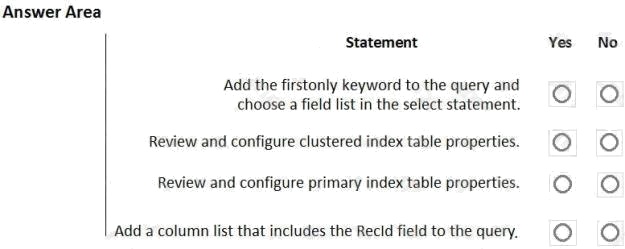
Answer:
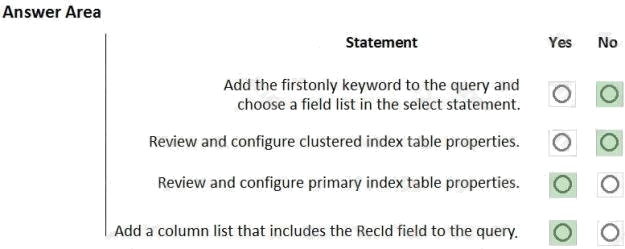
Explanation:
Scenario: User2 reports performance issues when they generate direct delivery purchase orders after current updates are
applied.
Also: You must implement validation to check whether a proposed direct delivery purchase order vendor is on the exclusion
list for the customer and product combination.
Box 1: No
The firstOnly keyword helps speed up the fetch by returning only the first row.
Box 2: No
Box 3: Yes
Box 4: Yes
RecId stands for Record Identifier. It is often called RowId (row identifier). It is a unique and incremental value stored with
each and every row of the table. In Microsoft Dynamics AX 2012 and Microsoft Dynamics 365 for Finance and Operations,
RecId is used as unique identifiers and to create relations between tables.
Another important point is the difference between RecId and Id. In simple words, RecId is generated by the kernel whereas
the Id is generated by the application itself.
RecId is used to find out the unique row in the table.
Reference: https://docs.microsoft.com/en-us/dynamics365/fin-ops-core/dev-itpro/dev-ref/xpp-data-query
https://community.dynamics.com/ax/b/nevoitechax/posts/what-is-recid-in-microsoft-dynamics-ax-365fo
Design and Develop AOT Elements
Question 9 Topic 4, Case Study 4Case Study Question View Case
HOTSPOT
You need to modify the CashDisc form to meet the requirements.
Which objects should you use? To answer, select the appropriate options in the answer area.
NOTE: Each correct selection is worth one point.
Hot Area: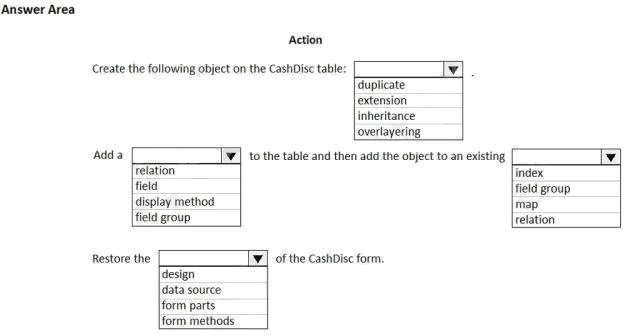
Answer:
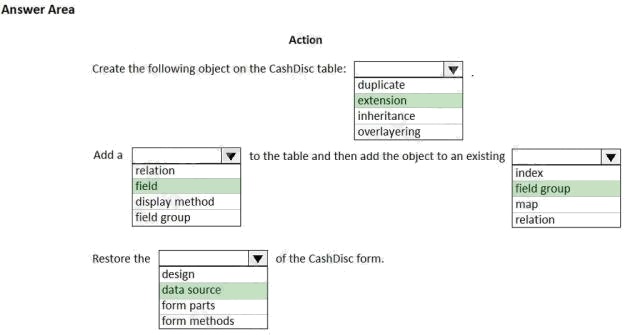
Explanation:
Scenario: CashDisc form
You must extend the CashDisc form to add a new field named MinimumInvoiceAmount to the form. You must add a new
Extended Data Type to the extension model for the new field. The new field must be added above the discount method field.
The field must display 10 characters.
Box 1: extension
To add a new field to an existing table, you must first create a table extension.
Box 2: field
Box 3: field group
Box 4: data source
Often, the information that is stored in existing tables doesn't satisfy customer requirements. Therefore, additional tables
must be created, and data from those tables must be shown on pages.
You can add new data sources to existing forms through extension. Follow these steps.
1. In the extension model, create a form extension for the selected form.
2. Right-click the form extension, and then select New Data Source.
Reference: https://docs.microsoft.com/en-us/dynamics365/fin-ops-core/dev-itpro/extensibility/add-datasource
Question 10 Topic 4, Case Study 4Case Study Question View Case
You need to modify the environment to meet the requirements for the Cash Discount Records report.
What should you do?
- A. Create an extension of CashDisc in a new project and add the field to the extended table.
- B. Create a new table named CashDiscExtension in the project.
- C. Use Open Designer to add the field to the table.
- D. Create an overlayer of CashDisc in a new project and add the field.
Answer:
A
Question 11 Topic 4, Case Study 4Case Study Question View Case
You need to update the CashDisc report to meet the requirements.
What should you do?
- A. Delete the existing CashDisc report in the extension model and create a new report.
- B. Extend the existing CashDisc report in the extension model and add the new field to the design.
- C. Duplicate the existing CashDisc report in the extension model and add the new field to the design.
- D. Customize the existing CashDisc report in the overlayering model and add the new field to the design.
Answer:
B
Question 12 Topic 5, Case Study 5Case Study Question View Case
You need to implement the migration requirements.
Which two options can you use? Each correct answer presents a complete solution.
NOTE: Each correct selection is worth one point.
- A. a data entity and bring your own database (BYOD)
- B. a public data entity and the Excel add-in
- C. a data entity and Entity store
- D. a data entity and a Data management import job
Answer:
B C
Explanation:
Scenario: Implement the Excel integration for the Vendor Exclusion List form.
B: By opening entity data in Excel, you can quickly and easily view and edit the data by using the Excel add-in.
Reference:
https://docs.microsoft.com/en-us/dynamics365/fin-ops-core/dev-itpro/office-integration/use-excel-add-in
https://docs.microsoft.com/en-us/dynamics365/fin-ops-core/dev-itpro/analytics/power-bi-integration
Question 13 Topic 5, Case Study 5Case Study Question View Case
DRAG DROP
You need to implement the companys integration requirements.
Which integration strategies should you use? To answer, drag the appropriate integration strategies to the correct
requirements. Each integration strategy may be used once, more than once, or not at all. You may need to drag the split bar
between panes or scroll to view content.
NOTE: Each correct selection is worth one point.
Select and Place:
Answer:

Explanation:
Box 1: asynchronous
An asynchronous pattern is a non-blocking pattern, where the caller submits the request and then continues without waiting
for a response.
Box 2: Synchronous
A synchronous pattern is a blocking request and response pattern, where the caller is blocked until the callee has finished
running and gives a response.
Box 3: Synchronous
Box 4: asynchronous
Batch data is asynchronous.
Reference: https://docs.microsoft.com/en-us/dynamics365/fin-ops-core/dev-itpro/data-entities/integration-
overview#synchronous-vs-asynchronous-integrationpatterns
Question 14 Topic 5, Case Study 5Case Study Question View Case
You need to investigate the Vendor exclusion list issue.
What should you do?
- A. Navigate to the General tab, select Record Info, and then select Show all fields.
- B. Navigate to the General tab and select Personalize this form. Add a field button and the required field.
- C. Navigate to the Options tab, select Record Info, and then select Show all fields.
- D. Navigate to the Options tab and select Personalize this form. Add a field button and the required field.
Answer:
C
Explanation:
Scenario: A sales manager suspects a data-related issue in the vendor exclusion list. User1 must identify the user who
created the referenced exclusion records.
Select Record Info, and then selecting Show all fields will display the CreatedBy field which shows the name of the user
who created the record.
Question 15 Topic 5, Case Study 5Case Study Question View Case
You need to implement the payroll application data process.
Which two objects should you create? Each correct answer presents part of the solution.
NOTE: Each correct selection is worth one point.
- A. a data contract class that uses the DataContractAttribute attribute
- B. a service class that has a public method which accepts a single parameter for a contract
- C. a class that extends SysOperationServiceBase
- D. an UIBuilder class that extends SysOperationAutomaticUIBuilder
Answer:
A C
Explanation:
Scenario: You must develop a process to import payroll journals into the system.
A: Data Contract: Data contract class is the model class defining attributes needed for batch operations. These attributes are
provided by the user, in a dialog. DataContractAttribute attribute is needed for the class and the properties methods requires
DataMemberAttribute attribute.
C: Service: Service class extends from the SysOperationServiceBase class and contains the business logic for the batch
operation. Developers often tend to add the business logic in controller classes, which violates the Single responsibility
principle.
Incorrect Answers:
D: UI Builder: UI Builder class extends from SysOperationAutomaticUIBuilder class and is used for adding custom behavior
to dialog / dialog fields dynamically constructed by the SysOperation framework.
Reference: http://daxingwitheshant.blogspot.com/2018/06/sysoperation-framework.html